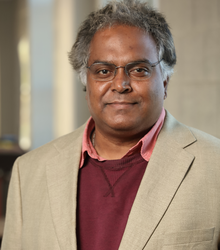
Utpal Chatterjee
Ph.D., 2007, University of Illinois - Chicago
Associate Professor
Experimental Condensed Matter Physics
Research Interests
My research is focused on a branch of physics, commonly known as condensed matter physics, which is essentially the study of physical properties of matter in their liquid or solid state employing the principles of quantum as well as statistical mechanics. My research interest lies in the experimental investigations of various solid state systems which exhibit novel electronic and magnetic properties, such as cuprate high temperature superconductors, colossal magneto resistive manganites, different transition metal dichalcogenides hosting charge density wave (CDW) as well as metal insulator (MI) transition and a number of narrow band gap semiconductors displaying unique topological and thermoelectric properties.
Typically, crystals in solid state systems are formed due to periodic arrangement of atoms and when such crystals are formed, the so-called core electrons, remain tightly attached to their respective atomic nuclei and do not play any major role to determine their physical properties. However, the valence electrons, i.e., the outermost ones, are loosely bound to their nuclei and hence, have the liberty to move around the crystals. It is the collective dynamics of these valence electrons (typically on the order of Avogadro's number~1023), which are responsible for majority of the interesting properties of these materials.
In my research, I employ an experimental probe, known as Angle Resolved Photoemission Spectroscopy (ARPES), which is based on light-matter interaction. In ARPES, a photon strikes a sample, from which an electron is ejected as a consequence. Using modern electrostatic analyzers, energy w and momentum k of the ejected electron are simultaneously measured and from such measurements one can immediately obtain w, k information concerning the electronic state inside the sample, i.e. the band structure, via conservation laws for energy and momentum. In complex materials, such k-resolved information is often crucial because, in general, the interactions have strong k dependence. The knowledge of w dependence is also vital since it provides information on the dynamics of these interactions. By adding a Mott detector to the electron analyzer, it is possible to acquire knowledge of the electronic spin textures. In a nutshell, ARPES together with its advanced forms provides the complete set of quantum numbers of an electron in a solid, i.e. energy, momentum and spin. Such a comprehensive knowledge of electronic structure in a material is extremely valuable since they not only determine the bonding among atoms and the resulting atomic structure and lattice vibrations; but also the electrical, thermal, optical, mechanical, magnetic, and chemical properties.
Some of the current research topics are (i) spectroscopic characterization of pseudogap and strange metal phase of BISCO 2212 high temperature superconductors, (ii) investigation of different phases in intercalated transition metal dichalcogenides undergoing disorder-driven CDW quantum phase transition, (iii) exploring novel physics due to interconnection between strong electronic correlation and spin-orbit interactions in 5-d transition metal oxides, (iv) investigation of MI transition NiS(2-x)Sex.
Selected Publications
1) U. Chatterjee. Ai, J.Zhao, S.Rosenkranz, A. Kaminski, H. Raffy, Z. Z. Li, K. Kadowaki, M.Randeria ,M. R. Norman, J.C.Campuzano,“Electronic phase diagram of high-temperature copper oxide superconductors” Proceedings of the National Academy of Sciences 108, 9346-9349, 2011.
2) U. Chatterjee, M.Shi, D. Ai, J.Zhao, A. Kanigel, S.Rosenkranz, H. Raffy, Z. Z. Li, K. Kadowaki, D. G. Hinks, Z. J. Xu, J. S. Wen, G.Gu, C. T.Lin, H. Claus, M. R. Norman, M.Randeria, J.C.Campuzano, “Observation of a d-wave nodal liquid in highly underdoped Bi2Sr2CaCu2O8+d ” Nature Physics 6, 99-103, Feb 2010
3) A.Kanigel, U.Chatterjee, M.Randeria, M.R.Norman, G.Koren, K. Kadowaki J.C.Campuzano, “Evidence for pairing above Tc from the electronic dispersion in the pseudogap phase of cuprates”, Physical Review Letters 101. 137002, Sept, 2008
4) A.Kanigel, U.Chatterjee, M.Randeria, M.R.Norman, S.Souma, M.Shi, Z.Z.Li, H.Raffy, J.C.Campuzano, “Protected nodes and collapse of the Fermi arcs in high Tc cuprates”, Physical Review Letters 99,1 57001, October 2007
5) A.Kanigel, M.Shi, M.R.Norman, M.Randeria, U.Chatterjee, M.Shi, A. Kaminski, H.M.Fretwell, K.Terashima, T.Takahashi, K.Kadowaki, S.Rosenkranz, J.C.Campuzano, “Evolution of the pseudogap from Fermi arcs to the nodal liquid”, Nature Physics 2, 447-451, July 2006.
6) U.Chatterjee, M.Shi, A. Kaminski, A.Kanigel, H.M.Fretwell, K.Terashima, T.Takahashi, S.Rosenkranz, Z.Z.Li, H.Raffy, A.Santander-Syro, K.Kadowaki, M.R.Norman, M.Randeria, J.C.Campuzano “Non dispersive Fermi arcs and the absence of charge ordering in the pseudogap phase of Bi2Sr2CaCu2O8+d”, Physical Review Letters 96, 107006, March 2006
News Items
Departmental Committees
Outstanding Undergraduate and Graduate Student Award Committee (Chair)
Undergraduate Scholarships and Fellowships Committee (Member)
Graduate Program Committee (Member)
 Physics at Virginia
Physics at Virginia